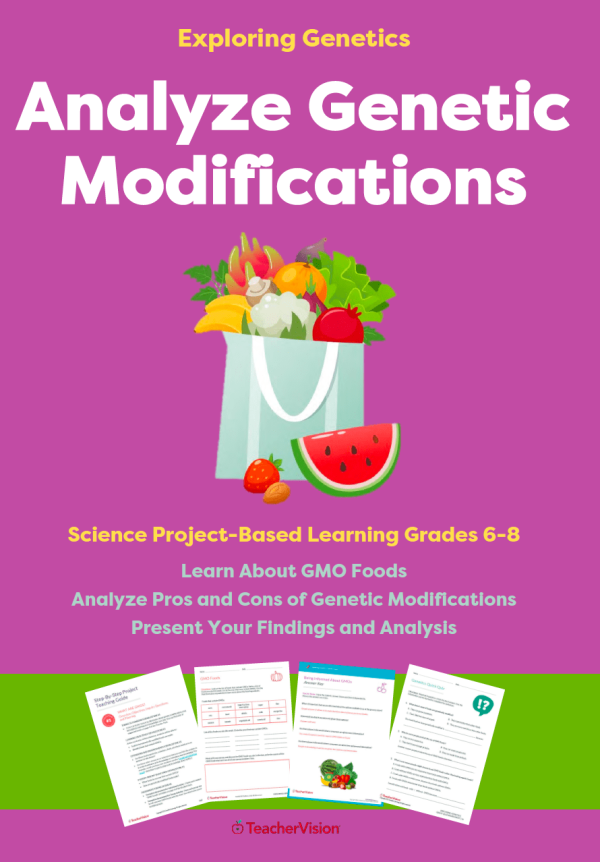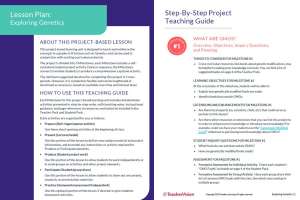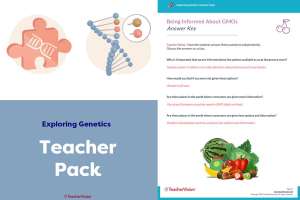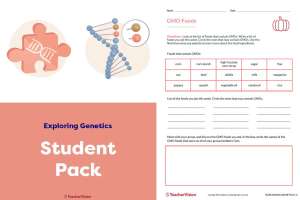
A Comprehensive Lesson on Genetically Modified Organisms (GMOs)
Build background knowledge of how GMO crops and foods are made, learn about the pros and cons of genetic modifications to food through inquiry-based activities, work hands-on to do a cost/benefit analysis of GMO vs. organic food, and design, create, and present persuasive educational materials to support your position on genetically-modified foods!
Your students will combine critical thinking, math, science, and persuasive writing skills in this project-based learning unit for grades 6-8 science. They'll learn about how organisms are modified genetically to make crops and food, use their analytical, math, and problem-solving skills to understand the pros and cons of genetic modifications, and "show what they know" by designing and creating a a series of educational materials to support their opinion of the benefits or harms of GMO foods.
What's Inside
Packed with hands-on inquiry-based activities, extensions and enhancements, cross-curricular independent and group work, and engaging and interactive challenges, this 52-page project-based unit comes complete with:
- For the Teacher: A complete Genetics Lesson Plan with step-by-step instructions for all activities, teaching tips, assessment guidance, and inquiry questions.
- For Students: A full-color Student Pack complete with all of the printables, slides, photos, and instructions students need for the research, experiments and activities - just print (or share) and teach!
A complete, ready-to-teach Teacher Pack that includes:
- Teacher versions of all the student printables with step-by-step annotations and notes for teaching GMO concepts;
- Formative and summative assessments, answer keys, and a full project rubric;
- Instructions and guidance for the extension activities and project enhancements;
- Materials and resources lists, links to articles, videos, and research, plus additional resources for lecture and presentation.
What's Included
Lesson Plan - Step-by-Step Project Guide
- Milestone 1: What Are GMOs?
- Milestone 2: Are GMOs Good or Bad?
- Milestone 3: Comparing Costs
- Milestone 4: Genetically Modified Foods Project
- Milestone 5: Project Presentations
Teacher and Student Resources
- Materials List for the Projects in this Unit
- Books About Genetically Modified Foods (optional)
- What is Genetically Modified Food? Activity and Answer Key
- Milestone #1 Inquiry Question Writing Prompt
- What Do You Know About GMOs Interview Activity
- Milestone #2 Inquiry Question Writing Prompt
- What's the Deal with Genetically Modified Foods? Activity and Answer Key
- GMO: Friend, Foe, or I Don't Know Posters Activity
- Genetics Quick Quiz and Answer Key
- Meal Planning GMOs/Non-GMOs Activity
- Mealtime Math GMO/Non-GMO Food Costs Research Activity
- Milestone #3 Inquiry Question Writing Prompt
- Wheel of Chance GMO Foods Activity
- GMO Foods Project Guidelines and Instructions
- GMO Foods Project Planning Sheet
- Milestone #4 Inquiry Question Writing Prompt
- Being Informed About GMOs Activity and Answer Key
- Milestone #5 Inquiry Question Writing Prompt
- Genetics Summative Assessment and Answer Key
- Genetics Project Rubric



OVERVIEW:
This project-based learning lesson is designed to support and reinforce the concepts taught as part of a science lesson or unit on genetics and DNA. It is built around 5 inquiry-based milestones that incorporate cross-curricular hands-on projects, formative and summative assessments, independent and group activities, and extensions.
STUDENT/GROUP OUTPUT:
In the course of this project-based learning unit, students will:
- Build background knowledge about genetically-modified organisms (GMOs) and their uses in crops and food;
- Explore the pros and cons of GMO crops and foods;
- Perform a cost/benefit analysis of GMO crops and foods vs. organic, non-GMO crops and foods;
- Define and develop a personal opinion position on the benefits and risks of genetic modifications to food;
- "Show what they know" by designing and creating a set of educational materials that supports their opinion about the benefits or risks.
SUGGESTED SUBJECT PREREQUISITES:
Students will acquire necessary background knowledge of GMO foods as part of this project, and instructional materials for providing that background are included in the Teacher Pack.
SEQUENCE AND PACING:
This project-based unit is divided into 5 milestones. The minimum suggested duration for completing this project-based unit is 5 class periods. However, the unit is completely flexible can be lengthened or shortened as necessary or desired, based on available class time and interest level.
TECHNOLOGY RESOURCES (suggested):
- Internet access
STANDARDS ALIGNMENT:
These activities support the following NGSS curriculum standards:
- LS1.A: Structure and Function
- LS1.B: Growth and Development of Organisms
- LS3.A: Inheritance of Traits
- LS3.B: Variation of Traits





